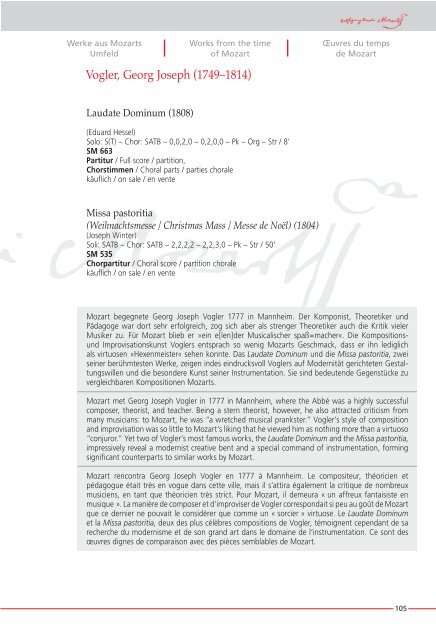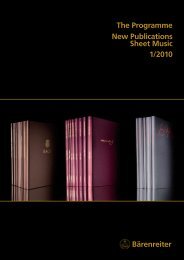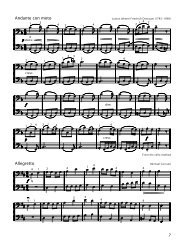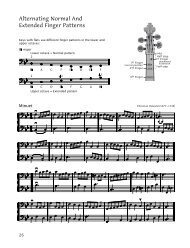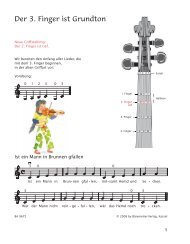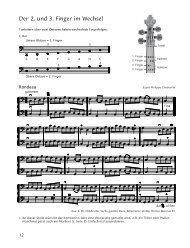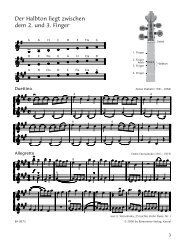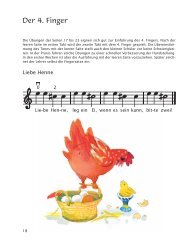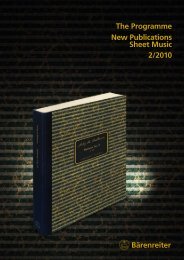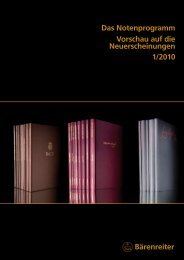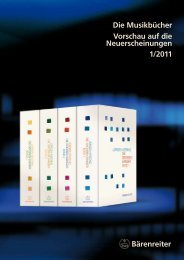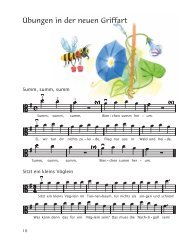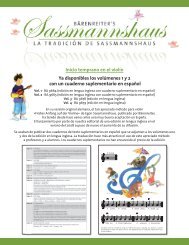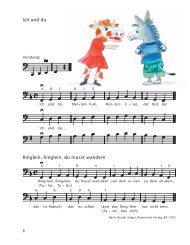You also want an ePaper? Increase the reach of your titles
YUMPU automatically turns print PDFs into web optimized ePapers that Google loves.
<strong>Werke</strong> aus Mozarts<br />
Umfeld<br />
Works from the time<br />
of Mozart<br />
Vogler, Georg Joseph (1749–1814)<br />
Laudate Dominum (1808)<br />
(Eduard Hessel)<br />
Solo: S(T) – Chor: SATB – 0,0,2,0 – 0,2,0,0 – Pk – Org – Str / 8’<br />
SM 663<br />
Partitur / Full score / partition,<br />
Chorstimmen / Choral parts / parties chorale<br />
käuflich / on sale / en vente<br />
Missa pastoritia<br />
(Weihnachtsmesse / Christmas Mass / Messe de Noël) (1804)<br />
(Joseph Winter)<br />
Soli: SATB – Chor: SATB – 2,2,2,2 – 2,2,3,0 – Pk – Str / 50’<br />
SM 535<br />
Chorpartitur / Choral score / partition chorale<br />
käuflich / on sale / en vente<br />
Œuvres du temps<br />
de Mozart<br />
Mozart begegnete Georg Joseph Vogler 1777 in Mannheim. Der Komponist, Theoretiker und<br />
Pädagoge war dort sehr erfolgreich, zog sich aber als strenger Theoretiker auch die Kritik vieler<br />
Musiker zu. Für Mozart blieb er »ein e[len]der Musicalischer spaß=macher«. <strong>Die</strong> Kompositions-<br />
und Improvisationskunst Voglers entsprach so wenig Mozarts Geschmack, dass er ihn lediglich<br />
als virtuosen »Hexenmeister« sehen konnte. Das Laudate Dominum und die Missa pastoritia, zwei<br />
seiner berühmtesten <strong>Werke</strong>, zeigen indes eindrucksvoll Voglers auf Modernität gerichteten Gestaltungswillen<br />
und die besondere Kunst seiner Instrumentation. Sie sind bedeutende Gegenstücke zu<br />
vergleichbaren Kompositionen Mozarts.<br />
Mozart met Georg Joseph Vogler in 1777 in Mannheim, where the Abbé was a highly successful<br />
composer, theorist, and teacher. Being a stern theorist, however, he also attracted criticism from<br />
many musicians: to Mozart, he was “a wretched musical prankster.” Vogler’s style of composition<br />
and improvisation was so little to Mozart’s liking that he viewed him as nothing more than a virtuoso<br />
“conjuror.” Yet two of Vogler’s most famous works, the Laudate Dominum and the Missa pastoritia,<br />
impressively reveal a modernist creative bent and a special command of instrumentation, forming<br />
significant counterparts to similar works by Mozart.<br />
Mozart rencontra Georg Joseph Vogler en 1777 à Mannheim. Le compositeur, théoricien et<br />
pédagogue était très en vogue dans cette ville, mais il s’attira également la critique de nombreux<br />
musiciens, en tant que théoricien très strict. Pour Mozart, il demeura « un affreux fantaisiste en<br />
musique ». La manière de composer et d’improviser de Vogler correspondait si peu au goût de Mozart<br />
que ce dernier ne pouvait le considérer que comme un « sorcier » virtuose. Le Laudate Dominum<br />
et la Missa pastoritia, deux des plus célèbres compositions de Vogler, témoignent cependant de sa<br />
recherche du modernisme et de son grand art dans le domaine de l’instrumentation. Ce sont des<br />
œuvres dignes de comparaison avec des pièces semblables de Mozart.<br />
105


